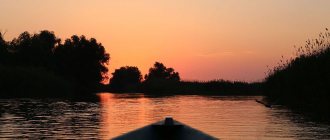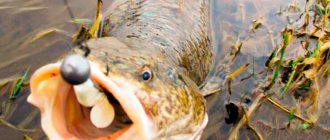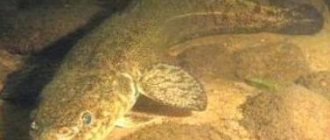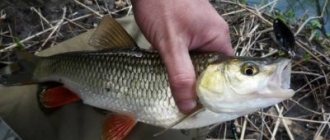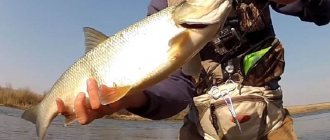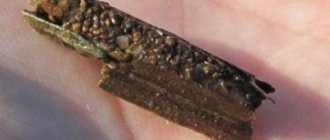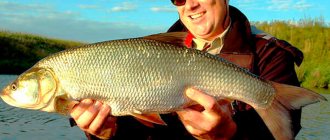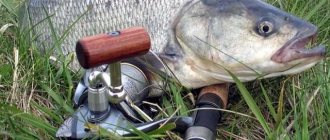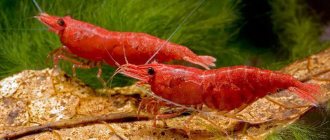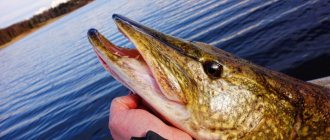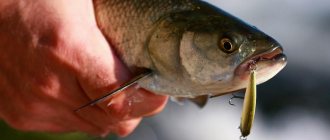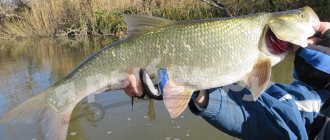Personally, it seems to me that on the Volga below Astrakhan, catching only three species of fish can be considered worthy in terms of trophies - catfish, carp and asp. The question, of course, is debatable, but I consider it from the perspective of a St. Petersburg fisherman, not burdened by the absence in nearby reservoirs of almost any fish characteristic of the European part of Russia, and even of the Volga.
One of the most constant predators in our waters in its habits is the asp of the Volga delta. And it's good that this is so.
People go to the Delta for all sorts of things. Some people like to fish for pike, some for pike perch, some for perch, and some for roach in general. But having tried all this in those conditions, I fully felt the effect of deja vu.
Indeed: fishing on compact points for medium-sized pike perch is no different from that on the rivers of the North-West (on our Vuoksa, for example, there are a decent number of very similar places - small coastal holes with powerful “returns”). Yes, this is the same jig for almost the same baits. The decoration is only different: instead of granite and pine and birch trees, there are reeds and poplars.
The rumbles themselves, where pike mainly live, are very reminiscent of the characteristic places for pike fishing in our area. The same depths of a meter and a half, cattail reeds and other salads. The pike is the same, in the same average size and with approximately the same habits as on well-known lakes or individual water areas of our large reservoirs, which can be called “mega-toads”, where many of us fish for pike. Over the course of a year, this experience is already gained in abundance. And you don't need to travel anywhere. And if you go specifically for pike, then go to the “north”. The only difference is that we don’t have a lotus. And this is truly a beautiful plant (photo 1).
In principle, it’s not worth talking about perch: with the proper experience in choosing fishing spots and the right gear, the number of casts equals the number of perch. Or even two per cast (photo 2). The weather there, the time of day - none of this matters. It gets boring very quickly and is used for culinary tasks or as a way to husk seeds to pass the time. And the Delta perch is completely uninteresting as a fighter: even on light tackle, and even large ones, the resistance is much less active compared to its northern river counterpart. It twitches a little at the beginning, and then it walks like a silver bream or even drags along the surface. And there are problems in the Delta with the actual trophy size of this entire trio. There are a lot of perch, yes, but not interesting ones. Especially when it’s not the first day you’ve been catching it.
There are also herring and rudd - very worthy comrades in terms of the sportiness of catching them. But herring, unfortunately, is a short-lived phenomenon. Rudd, on the other hand, lives sedentary and everywhere, grows to a decent size and differs from our northern ones in its increased predation and excellent positive reaction to many types of spinning baits (photo 3), even to topwaters. And for me personally, these goldfish are much more interesting in terms of catching than the entire “black” predator combined, if we are talking about the Volga. But still, this is a fish from the lower weight categories. But I want to butt heads - to fight with someone more serious. This is where we come to the triumvirate that we talked about at the very beginning. Wild carp is, of course, very cool. This is power, even if small (photo 4). But this is not spinning, with rare exceptions, but a separate specialized type of fishing, which also requires a long constant presence near stationary gear.
Catfish fishing is also specific, mostly with natural baits. Of course, you regularly come across it when catching other fish, but if you went after it specifically, then it’s better to put off the spinning rod, and replace it with powerful bottom or side tackle and prepare a supply of “white” for cutting, catching frogs or shooting and digging up some . And it won’t hurt to master the quok. The probability and reliability of capture will then increase by an order of magnitude. Although catfish are also a very serious opponent when fishing, and a very tasty companion for the table in any form. An excellent trophy in all respects (photo 5).
Well, what if you don’t want to sit on the shore or on a boat in languid anticipation of a powerful stretch? And don’t you also have a desire to catch an ordinary predator? That's right, let's go after the asp!
I’ll say right away that we will talk exclusively about casting fishing. And not because I have a bad attitude towards catching asp by trolling. It’s just that in the conditions of the Delta, this is, as a rule, much more difficult to implement in practice than on the main Volga (or Akhtuba) above Astrakhan. In most cases the scale is not at all the same. Watercourses are often very narrow and, in addition, winding, actively changing depths, a huge number of snags due to wood settling at the bottom. Plus, the structure of the banks in the lower part of the Delta is completely different, and this fundamentally changes the asp sites - and it simply becomes (for physical reasons) inaccessible to trolling.
In the upper part of the Delta, where there is no such fragmentation of channels yet and many branches are quite wide, there are more opportunities. But there are some nuances here too. For example, many constantly operating ferry crossings between all the major islands of the Delta will not add convenience to such fishing. And the asp, he’s an infection, hangs around next to them. The ferry passed and there was a revival on the surface. We must stay at anchor and wait. You can’t catch the obviously most lethal asp points either, because they are constantly caught in the classic way, by casting. If you don’t blatantly cross under the engine, you might accidentally get hit in the head with a Kastmaster. In general, too much, in my opinion, needs to fuss for results. It's not worth it.
And catching asp with a classic spinning rod is still, I’m not afraid of such lofty words, a noble occupation. One of the textbook hunts. Both in terms of the quality of adrenaline received when catching this fast-moving roach, and in terms of satisfaction from the result obtained, very few freshwater fishing can compete with this fishing.
Having rummaged through old magazines collected over the past 10–12 years and found all the materials on the Volga delta, or rather on the asp, it turned out that almost everything remained the same as it was. At the same technical and tactical level. Maybe the gear is changing - spinning rods are “faster”, the lines are thinner, the reels are lighter, but the principles and techniques of fishing are the same, and by and large, all these advances do not have a very strong effect on the result, more on the pleasure of the fishing process . After all, the asp of the Volga delta and the asp in the North-West are two big differences. And if in our area we have to use all the achievements of progress to the maximum in order to achieve results, then in Astrakhan you can take a kit with a total cost of two thousand - and not know grief. Being (conditions) in this case determines consciousness. Materialism…
Maybe since nothing is changing, this article shouldn’t have started? How about just referring to old materials? But no, there is something new. And it won’t hurt to refresh your memory of what you’ve covered either. After all, the season has already begun a long time ago. And after the flood and midges, the main period of asp fishing in the Delta will begin.
The main feature of catching local asp
When I first saw the water of the fast-flowing channels of the Delta, I was seriously puzzled. In our area, with such transparency, they don’t even think about spinning. It is simply impossible to catch anything in such water. Fishing can only be done on the bottom, or on a float in areas of weakened current. Water - station coffee with milk photo 6). Like during the peak of the spring flood somewhere in Luga or Meta. You lower the wobbler near the side - half a meter from the surface you can’t even see a damn thing about it. In some places the transparency is better, in some channels where the current is slower, in some places it is worse, but in general the picture is approximately the same.
It turned out that all this is normal, as it should be. This leads to one of the main advantages of asp fishing in these conditions - fishing distances are reduced to almost minimum. If an asp patrols along the very surface, then, of course, he sees something, but the safety distance he maintains, compared to the mounted asp of our rivers, is simply ridiculous. It can be easily reached with a relaxed cast at 30 - 40 m. This distance to the striking asp is quite enough for it not to be afraid of you (photo 7). If the asp walks or stands a little deeper, on a meter, then he is no longer afraid of anything. And it can actively hunt even ten meters from the boat. A couple of times an asp took a three-ruble note from me when there was a meter of cord left from the tip of the spinning rod to the spinner, that is, while taking out the bait. From somewhere far away, the asp was following the lure - and couldn’t resist at the last moment. At the same time, neither the sun in the whole sky, nor the calm smooth current, nor the boat casting a shadow, nor the people standing at full height bothered him. (In our area, for example on Meta, I saw this only a couple of times, and then in conditions of very late evening and difficult surface currents, and the size of the fish was more modest.) One of the main tactical fishing schemes is based on this basis - rafting, when drifting a short distance from the shore and casting short casts around the coastal shelters, you can count on catching a very serious asp.
Fishing for asp in the Lower Volga
Fishing areas Asp, or sheresper, is one of the most timid and cautious fish. Therefore, hunting for this cunning predator is always difficult and interesting. If you almost always, at any time of the year, know where and what to catch for pike, then fishing for sheresper should be thoughtful and based on many factors. Depending on the water level, weather, and other minor details, the asp can be in completely different places. All this concerns the Lower Volga. Our task is to find him and make him covet the bait. It is very difficult to describe all the places and equipment in one article; I will focus on one favorite period, the decline in water after a flood. At the end of May and beginning of June, depending on the end of the spring flood, when the water level drops by a couple of meters, but is still far from the usual summer level, the asp, having rested from spawning, begins to become more active. Strong and nimble fish, accustomed to living on the current, do not stay long on quiet-water spawning grounds and, at the first opportunity, go to eriks and rivers with fresh running water. Interestingly, asp captures in fields (spawning areas) are very rare, and the specimens are small. But when a predator rolls onto the river, quite decent sherepers end up here. Let's get down to business. Usually the water level drops very sharply at the end of a flood. At the first moment the water recedes, the current and level in Akhtuba and the Volga are still high; the search for a predator should begin on large eriks penetrating the Volga-Akhtuba floodplain. Many small rivers and streams flowing from the fields converge into these large water arteries, and it is in these places that you should look for asp. But there is one trick. The outlet of the stream into the erik must be deep, otherwise the cautious fish have nowhere to hide. In such places, juvenile fish begin to roll off the spawning grounds, followed by small predators, mainly perch, which the asp hunts for. Literally a week or two after the beginning of an active decline in water, the sheresper goes to the rivers of its main habitat. But due to the high level and strong current, it does not occupy the usual places of residence, but is pressed closer to the shore in areas with a steep bank, rip currents and small creeks. Here he also chases a small predator, which in turn hunts for small fish that have rolled down from the spawning ground.
Fishing time I won’t reveal the secret if I say that you need to catch the asp in the morning. But for many people the morning starts very late. And when you, having told your friend where and how to catch a predator, hear that he, having been to the treasured place, did not catch anything, the reason
becomes clear. It is necessary to be at the fishing spot in the dark, or more precisely, at the very point of fishing, you should settle down at the beginning of dawn, when it is difficult to tie a lure without a flashlight. Then success is guaranteed. But all active fishing can last no more than two hours, and as soon as the morning rays of the sun begin to stroke the water surface, bites become rare and cautious. Of course, you can catch a sheresper for up to ten or eleven hours, but the result will not be great. Yes, and you will have to iron a lot of places with a spinning rod. In the evening, of course, you can also get a bite, but it is even shorter and unpredictable. At the very moment of sunset, when there is half an hour left before twilight, there is a chance to try your luck. But, frankly speaking, it is better to give this time to other underwater inhabitants. In general, here, as nowhere else, the saying applies: “He who gets up early, God gives to him.” It’s not for nothing that I mentioned above about the asp’s hunt for perch. The fact is that there is a misconception that the asp, after the water recedes, chases the young fish. You can easily buy into this, seeing how the small silver fry scatters in different directions due to the violent splash of a predator. But that's not true. If a large sheresper fed only on tiny fry, it would have died long ago from exhaustion. The fact is that small pikes, asps, and perches, carried away by the hunt for young fish, lose their vigilance and fall into the toothless mouth of the sheresper. So, during this period, the most catchy baits are poppers; they imitate the play of a feeding perch, which is what attracts the asp. The best performing poppers are the Lucky John Classic Pop, 8 cm long, in two colors - M-01 and S-07, and the Small Gangster model, 6.5 cm long, color S-07. One problem is that if the wind drives the wave, the popper becomes useless; wobblers with minimal depth come to the rescue. For example, the same Lucky John Basara 90F and 70F 104,105, 201 and 303 colors.
It is clear that the asp not only chases a gaping small predator and, if it manifests itself in bursts at a distance of ten meters from the shore and further, there is a high probability that it feeds either on bleak, or rudd or roach, which in turn feeds from the surface of the water . Here the popper will no longer work; you need to use turntables, most often silver in color, numbers from 1 to 3. Over the past year, Bonnie Blade turntables of many colors have worked well for me. The ubiquitous castmasters are also acceptable, the weight depends on the strength of the current and casting distance, usually up to 21 grams. The color is the same silver. Acme castmasters work best, but beware of fakes, they work much worse. It’s not difficult to recognize: the branded one costs about three hundred rubles, the left one costs no more than fifty dollars. This also applies to other baits. Left-handed wobblers, of course, can work, but you shouldn’t tempt fate - take proven ones, fortunately Lucky John is not so expensive. Tackle To fish for this strong, cautious predator, you need reliable tackle. Even if fishing is done from a boat, a spinning rod three meters long is a necessity due to possible long casts. Longer ones of 3.30 m can be more useful on the Volga, when a very long cast is required. And on eriks and streams, a three-meter one is enough. The spinning test is selected depending on the weight of the bait, personally I prefer the 10-40 g test, the spinning rod structure for this fishing is semi-parabolic. But this is my opinion, let everyone listen to their feelings and needs. As for brands, I like Black Hole and Daiwa. A reel for this type of fishing must combine two qualities: be powerful and at the same time fast. In a fast current, landing large fish is difficult, plus the asp must be taken away from the biting zone as quickly as possible, so as not to scare away your comrades. And the last twenty meters of the run are usually empty, the timid fish don’t come that close, so the bait must be taken out of the water as soon as possible and sent to the biting zone. Based on the above, you need a reel of 3500-4000 series according to the Shiman classification. From Shimano itself, for example, the Stradic or Biomaster series is suitable. As for the fishing line. Should I use braid or monofilament? If I were fishing at the end of summer or autumn, I would definitely say: monofilament. But when the water subsides, you can use a braided line. The turbidity of the water is increased, and the fish are not so afraid. But the clutch requires precise adjustment. The asp's lips are delicate, and strong jerks can lead to the loss of the trophy, since the braid is practically inextensible. But the feeling of the bait and the ability to give it the game that is necessary is much higher. And the diameter of the braid should not be set higher than 0.12-0.14 mm, we must not forget that we are dealing with a timid asp. It is clear that it is not recommended to install cords of bright colors; green or black are best. And it must be floating, since fishing takes place on the surface. I used to use Salmo Braid Elite, but now I’ve switched to Salmo Tournament WX8 - the eight-thread one is, of course, considerably more expensive, but it flies much better. The use of leashes is unacceptable, only a small reliable carabiner with a swivel on a bearing. There are, of course; annoying “cuts” with the teeth of the ubiquitous pike, but very rarely. More baits are lost on blind hooks. Personally, I don't use leashes. And finally, I recommend that you watch a short video about asp fishing in the Lower Volga.
The main advantages of catching asp in summer
Asp, in most regions, is a fish that can be caught all day long. Moreover, unlike other species that tend to be active only during low light hours, the asp has an excellent appetite all day long. Very often the largest asp is caught when the sun is hanging at its very zenith (photo 8).
The asp has no time to “act like an intellectual”; he is the most active predator, a car thief, with maximum energy consumption in the hunt - and the asp needs a lot of food. And the day on the Lower Volga is not very long even in the middle of summer. And in our area, on the same Vuoksa, even a June afternoon does not stop it. Although, it would seem, he could have rested during the white nights. I personally observed twice how asps were dragged out under the “tester” in the period from 12 to 14 hours. So in Astrakhan he has no time for sentimentality. Already everyone, except the perch, is leaving for a siesta, the temperature is 40 - 45 degrees, and the asp, you know, is threshing bleak. The only condition is more or less good, and most importantly, stable weather. Although before its sudden change to an unfavorable one, asp sometimes tend to significantly increase food activity, and in different regions, and you can get into a good deal. Although short-term, after which a phase of complete apathy will begin.
In mid-summer, few people go to the Delta, believing that there is nothing much to do there. It's low season. Many bases are empty. They even close completely for this period. The sun is merciless. The heat is terrible. Water that won't keep you cool. During the ripples the fish catch in the mornings and evenings. It's about the same in the ducts. Pike perch are semi-passive. Carp and catfish focus more on twilight. And only asp can be continued to be caught, no matter what. And it even makes sense to go specially for him at this time. When there are very few boats on the water, there is therefore no competition for fish. This is one of the important conditions for calm and effective asp fishing with a spinning rod. After all, there is nothing more upsetting for the asp hunter when a couple of boats with over-aged idiots and screaming girls on board fly past a flock of large asp that has just gone hunting.
Major caveat
If you are going to Astrakhan at the height of summer, especially for asp, you must be prepared in terms of clothing. Here you don’t need to think about insulation, protection from storms or rain (although having a light, full-fledged raincoat will not hurt at all: not from a thunderstorm, but it will protect you from the head wind when the boat rushes at dawn to the cherished points at maximum speed). And the heat in Astrakhan is very easy to bear.
The climate is sharply continental, even though the Caspian Sea is nearby. And the 45 degrees there are no worse than the St. Petersburg “thirty”. Our task is to take care of maximum salvation from the merciless sun, especially on water, which increases your radiation dose by reflection from its surface. The simplest and most correct thing is to look at how those going fishing in the tropics dress, and then buy the same thing for yourself. When this is not possible, you can get by with the public one. If we talk about underwear, the main requirements are as follows: it should be long, dense and light. From natural materials, if possible - cotton and linen (photo 9).
No shorts or T-shirts! Only full-length trousers and shirts. I somehow relaxed and decided to spend just a couple of hours in a T-shirt at noon. Even my forearms managed to burn during this time; it took two weeks to remove the skin from them. Although I don’t suffer from sunburn at all in my native climate. The headdress is also very important. Its job is to protect your ears and neck from the midday sun. A simple baseball cap is far from the best option. Toasted burgundy “ears” are little better than a toothache. Therefore, either a cap with a long flap, or a Panama hat, or a hat with a wide brim. Feet should be covered with socks if shoes are open. Light gloves are also advisable - they won't hurt.
And of course, don’t forget about glasses. At the same time, with the strongest UV protection. Again, we look at equipment for sea tropical fishing. There these are usually glasses with a mirrored outer coating. In most cases blue or green. Only they are guaranteed to protect your eyes, no matter how much you catch.
Lures for asp fishing
Asp is a fish that is unpretentious and conservative in relation to the types of bait. The list of baits that will catch him well can be long. Among their variety, the most popular among fishermen are artificial baits: castmaster, devon, triangular, wobblers.
Basic requirements for such baits:
- must have an elongated and narrow profile;
- be small in size;
- in free fall with pauses in the drive, have a bright game;
- have an intermittent shine.
A bait that meets these requirements will help the fisherman make long and accurate casts and will go deep even in strong winds and currents.
Devonian
To successfully catch asp in the Devonian, this bait must successfully combine ease of rotation, weight and compactness. This is a universal bait and is intended for catching not only asp, but also many other predatory fish that live in all layers of water.
In its form it happens:
- flat;
- round;
- facet prominent;
- cigar-shaped with blades on the sides.
With the correct lining technique, the Devon works well both in current and in still water.
Such baits have a significant mass and do not require sinkers to be attached to them, since the material for their manufacture is heavy metals (mainly lead).
Although you can also find Devon made of plastic, in this case it is necessary to attach a heavy sinker to it.
The weight and shape of the Devon allows the angler to make precise casts over a considerable distance. Once in the water, it begins to rotate immediately after it begins to reel in, thereby attracting fish.
The rapid rotation of its blades creates a strong sound of water, which makes the fish swim for the bait.
The speed of its rotation is affected by the shape, size and angle of the blades. When catching asp, they use a demon with a blade angle of 45-50 C, no more than 10 cm long and up to 3 cm wide.
They have a variety of colors, but Devons of golden and silver color are more common.
Triangular bait
The peculiarity of using a trihedron is that it is designed for fishing at depth. Compared to other baits, it goes to depth much faster, which is very important when fishing in the current.
The optimal weight of this bait can range from 12 to 21 g, but this is quite enough for the bait to cover a distance of up to 70 meters when casting. It is quite compact and has a narrow profile. If, when using it for fishing, you use a high speed of retrieval, the bait easily penetrates to the depth of the reservoir.
Knowing that asp reacts well to shine, trihedrons are produced mainly in two colors: golden and silver.
Castmaster bait
At the end of summer, the asp begins to gather in flocks. During their hunt, fishermen cannot get close to them. Therefore, during this period, castmaster works best of all baits.
This bait is simple in design and is an oblique cut of a cylindrical metal blank. They are light in weight: on the market you can find castmasters weighing 2.5-3.5 grams. The size of the bait depends on the weight of the spoon used.
For example, a nozzle weighing 2.5 g has a length of 3.2 cm, and one weighing 21 g has a length of 6.2 cm. The Castmaster is available in a classic silver color.
Retrieving using this bait can be either intermittent or even. This depends on the activity of the asp and on the layer of water in which it is located. The Castmaster bait always has a good action, regardless of the speed of its retrieval.
Where to look for and catch local asp
Just going out on the water and easily catching an asp with sabers drawn, as they say, for a fool, is unlikely to succeed. If only you're very lucky. For example, if you notice a single hunter cruising along the shore in the midst of an active meal, count him and throw the right bait at the right moment. Or you’ll come across a “battle”, a classic one, marked by screaming seagulls, which can be seen and heard hundreds of meters away. But in this case, most likely, the asp will be massive, but not large, in the “keel” area, otherwise you might even run into a completely “herring” one.
For warming up, of course, it’s not bad, but it will quickly get boring, because a medium-sized asp is a weak fighter even in the warm water of the lower Volga. It begins to show real resistance when it reaches a mass of about 2 kg. This is becoming a completely different fish - strong, fast, and takes a long time to tire. It shows maximum agility, approximately the same as a pike - at 3 kg. Then it begins to put more pressure on the mass and area of its body and caudal fin. To catch just such an asp, you need to know where to look for it. It’s good when there is a huntsman who knows how and where to catch the big ones, but it’s better that he does this himself periodically. Then your time, which, as we know, is money (and even more so money, often quite a lot), will be spent as efficiently as possible. After all, each base has tens of kilometers of river land, be it sections of banks, wide or narrow channels of the Delta. And sometimes during the day, fishing points are scattered at a distance of 30 - 40 km. Now imagine how much time it will take to independently explore such a water area! Especially if you do this in the middle of the day, when asp activity on the surface is minimal and, in addition, a decent wind is blowing. But let’s say there’s a problem with the rangers. Let's go on an independent search. What do we pay attention to?
Tackle
Catching an asp will require long casts. This is a cautious fish, with good eyesight, and it simply will not bite near an angler. Based on this, we select a rod with a length of about 3 (when fishing from the shore), or 2.5-2.7 (when fishing from a boat) meters with a spinning reel of 3-3.5 thousand and a fishing line of 0.15 - 0.20 mm. The tactics of catching asp also places special demands on the bait: if it is too light, it will be difficult to make a long cast. The optimal weight is about 20-30 g.
Most often, when going on an asp hunt, anglers prefer the following baits:
- “smart” spinner, or castmaster;
- “oscillators” and rotating spoons;
- Devon spinner;
- wobblers.
“Castmaster” is the leader in popularity among anglers, especially if you add a couple of streamers to the main spoon. This bait looks like a flock of fry, which attracts the asp. Maggot, cake or pieces of worm are perfect as complementary foods.
The Devon spinner is a metal version of a turbo bait. There are plastic and wooden propbaits, but it is the “Devon” that will be effective when catching asp. The bait not only creates waves and makes noise thanks to a small turbine. The metal emits bright reflections, which also attract a predator. This bait also has one more quality that makes it convenient for fishing. The spoon is quite heavy, and it is very convenient to cast it over long distances.
Rifles
Rolls - it must be said right away that the concept of “rolls” in the Lower Volga version is very different from the same in our northern version. If we approach a riffle here, it is usually a rapid current that nothing can hide, a slope of the stream noticeable even to the naked eye, and often additional sound accompaniment. In the Delta, you can often swim along a riffle and not notice it at all if there is no calm (photo 10). It can be determined in most cases only by the characteristic traces of flow turbulence that appear on the surface. These are the so-called “mirrors”. But the “mirrors” are not the ones that are familiar to pits and waterways, where they wander, protrude and are adjacent to whirlpools. The ones we need are almost stationary, and are formed in a direct flow at those points where the river stream hitting the bottom obstacle is reflected and rises to the surface. This very bottom obstacle does not necessarily go from bank to bank; these are not northern rivers with a stone or gravel bed. In our case, the width of the riffle can be only a couple of tens of meters with a total width of the watercourse of 150 meters. And this makes orientation even more difficult. The whole river is like a river, and only in the middle does it turn out that there is something extremely interesting. And you swim along the shore. But sometimes the roll goes across the entire channel, especially if it is not very wide.
Since Astrakhan is located generally below the level of the world ocean and on entirely soft sedimentary rocks, any transverse rise of the bottom by a couple of meters is already a rapid in those conditions. And usually the depth at its top is one and a half to three meters against the background of the surrounding three to seven. After a riffle, sometimes there may be a compact channel hole, or there may not be.
In any case, the asp appears in the area of the riffle during the day, unless the weather has any special surprises. In larger or smaller quantities, and the average size of the asp, depending on what is not clear, can change significantly. There is just no guarantee that the asp will be somehow active at the moment of your appearance. Therefore, it is necessary to constantly check this point. Today the asp will emerge at dawn, tomorrow at noon (photo 11), and the day after tomorrow - when the sun has already fallen below the horizon.
Moreover, each roll has its own life. For example, we caught here yesterday morning, we caught a good amount of large asp and a lot of them. The asp walked without much of a “fight”, but its powerful backs were constantly showing up at the surface - and it was not difficult to carefully present the lure right under the noses of the cruising asps. And on the next rift, a few kilometers away, another boat observed no bites and zero movement on the surface. The next morning, of course, everyone is here. But no! Silence. There's a call here. The picture has changed. It's the other way around. The next roll started working. Asp, from his neighborhood, wanted to eat this morning. Let's go there.
Returning in the evening, we decided to check the morning point. And just when the sun had already touched the tops of the trees, it began! The asp came out abruptly and en masse. The whole thing is from two to three kilos. And he was caught almost through the cast. Having arrived at the base in the evening, we learned that the nearby “delicious” points, not only the rifts, at the same time responded with complete lack of fish for those who wanted to catch an asp there. The most famous riffles in the evenings are most consistently visited by active, numerous fish - and it is better to focus on them at this time. You can catch the most impressive amount of asp in a minimum of time. Another good thing about fishing in these areas is that there is always a chance to catch a single, insignificant asp sticking to the bottom near the top of the riffle. And at any time of the day. On the most “trump” rifts, even if the fish are completely passive on this day, you will still, even if you suffer, catch your asp. Because he is registered here.
And another very important addition. Riffles are mainly a phenomenon of that section of the Delta where there are predominantly full-fledged solid shores. That is, the top one. If you climbed deep into the Delta, already to the Caspian Sea itself, then you need to focus on other points.
Where and when is the best fishing?
Asp is found everywhere on Akhtuba, but when going fishing, you need to take into account the time of year, period of day and water temperature. In summer, the predator hunts on the surface, but when it gets colder, it goes deeper and freezes near the wintering holes until spring, practically not feeding. There are always a lot of adults and young animals at the confluence of the largest branches of the Akhtuba - Mangut and Kharabalyk. The topography and abundance of small fish in these areas of Akhtuba create optimal living conditions for this fish, and therefore for fishing with abundant catch.
Shelesper spawns in April. This period occurs in pairs, with no more than a dozen adult individuals gathering in the spawning areas. Predators choose sandy rifts for this purpose. A week after spawning, the fish begins to eat. For this reason, the end of April and the beginning of May is a very favorable time for fishing. In summer, the asp leaves the sandy rifts and returns to its usual habitat - the river bed. Exits from backwaters and shallow waters are a favorite ambush spot when hunting. It loves warm water, so during the hot summer months it hunts on the surface near sand bars. By August, adults are no longer so wary. At dawn and dusk, they come out of hiding to catch any bait, and fishing becomes more fruitful. During the day you can also attract large specimens.
The autumn zhor begins in September. The grown young animals are collected in asp cauldrons. At this moment, fishing is possible only with bait on ultra-light tackle thrown along the stream. With the onset of October, when the river waters become cool, the asp goes into the depths and rises to the surface only to occasionally catch prey. Fishing is sluggish, baits need to be thrown “at mid-water”. In mid-autumn, you can catch trophy specimens weighing up to 10 kg or more in the waters of Akhtuba.
Winter fishing on Akhtuba will be successful near wintering pits. Silicone baits, foam rubber and traditional wobblers are used. For successful fishing, you should choose calm, warm and sunny days.
Asp fishing is most effective at dawn and before dark. At this moment he goes hunting. A hungry fish easily takes any bait. It is useless to wait for a bite at night. Unlike most freshwater animals, it hunts only during the daytime. Therefore, night fishing is ineffective.
Large riverbed snags
Large channel snags - Floods carry a lot of wood. After all, the banks are washed away, they collapse, and trees fall into the water along with them. Or their remains. Sooner or later they settle to the bottom. If this happens in the shallow lower Volga channels on the main current, and such a snag becomes clearly visible due to the fact that it comes almost to the surface or even sticks out of the water, then a very interesting and easily readable point for catching asp is formed (photo 13).
Behind a large snag, a pronounced zone of weakened current is formed, which attracts all the surrounding fish. The lower zone is occupied by catfish and carp. A lot of small items collect at the top. The asp is somewhere in the middle layer. A large flock of asp, of course, cannot fit here, but several individuals are sure to hang around nearby. Sometimes they can appear on the surface, especially in the evening, but this is not a necessary condition for fishing. Sometimes this point is favored by the most seasoned fish. Here there is shelter, protection from strong currents, and food is always abundant above your head: a couple of movements and you are full. In such a place there is a chance to hook an asp far beyond 5, or even 7 kilos. And this happens, albeit infrequently, but quite regularly.
When sailing past such a snag, you should never ignore it. It is imperative to anchor and make several control casts. It is better if there is more than one spinner in the boat - use fundamentally different baits, for example, Cas. Maybe something will go off at the moment. Sooner or later you will get lucky. In the morning, and especially in the evening before sunset, half an hour or an hour should be given all your attention to such a point, if you find yourself on it. The asp's exit to hunt can be sudden, short-lived and very active. You shouldn't yawn here. The number of trophies during the period of this output may correspond to the number of casts made.
Shore shelters
Coastal shelters - despite the fact that the asp is a fish of large expanses, it is not at all alien to the tendency to solitude and comfort, and far from strong currents. Asp loves to occupy secluded places almost near the shoreline (photo 14), be it large low-hanging trees, bushes extending into the water, coastal snags, drifts of all sorts of things, and even small pockets in the reed line.
At each such point there is potential. You just need to check them all. Constantly. There aren't too many of them in the Delta to miss. There are some channels, entire kilometers of which do not have any configuration that is so attractive to a serious asp. (After all, let’s not forget that we are in a semi-desert zone - and there are problems with vegetation, even coastal ones.) And there are those where, for hundreds and hundreds of meters, one promising point after another follows practically without intervals and all the fishing here consists of rafting along the shore and continuous fishing of the water's edge. This is one of the two main methods of catching asp in the Delta - raft fishing. And this is done with the help of classic oscillating spinners. The most interesting places, as a rule, are located in rather narrow watercourses closer to the Caspian Sea, because they have quite a decent depth right from the edge. And it’s quieter there, because the banks are difficult to access and heavily overgrown (photo 15). And on the large branches of the upper part of the Delta, it happens that a tree stands overhanging, spreading, with branches extending into the water. It looks gorgeous. You throw it, and under it there is a meter and a bare, flat bottom. And often there are enough people, noisy and catching - everyone wants some shade.
In addition, in small channels with a pronounced current, at any time of the day, even in the absence of special shelters, under the shore you can catch medium-sized foals up to 800 grams. On a small “spinner” or “spinner”. Anything is more interesting than “strangling” perches.
Arrows (aka “pants”)
Arrows (aka “pants”) are invariably present objects at the top and bottom of any river island (photo 16). They are interesting for all types of fish primarily because here complexly interacting currents (separating or merging) coexist with rich relief, and often with thickets of aquatic vegetation and settled snags. All this attracts clouds of small things, and, accordingly, a predator. Here the perch eats, and the resident pike is caught, and the asp comes here regularly.
When the arrow has an extensive zone of sediment occupied by grass, immediately followed by a dump in depth and a stream, then the border of the grass, especially in the area of the top, is a promising area for fishing throughout the day. The deposit area on the arrow may be the same as in photo 17. After a couple of steps it will be already with the head. It is at this point that they take the asp almost from under his feet. And often it is at noon, in the thick of it, that such points should be processed, because here an active daytime single asp always appears, which is not difficult to seduce with bait. At the same time, it is not at all necessary to catch “with a splash”. It cruises next to the “greenery” somewhere along the dump and periodically, if necessary, rises to the surface, but it also hunts in the lower layers, and therefore is easy to catch. Sometimes there are no superficial manifestations at all, but the asp nevertheless occurs regularly.
Place and time of asp fishing
Asp bite in Astrakhan at any time of the year. However, she is a very cautious slave and is not easy to catch. But the trophy is even more desirable for an experienced fisherman. The minimum bite is during high water: this predator is not a fish that is easy to catch in troubled water. The asp relies mainly on vision in hunting, and in turbulent spring rivers it is a poor helper. Therefore, the fish prefers to wait until the silt settles and visibility improves. When the meltwater level subsides, the bite is restored and fishermen can go fishing.
In summer, you should look for asps on rapids, rifts, and the boundaries of rapids. He especially loves places where the bottom is uneven, or there are drifts and snags on it. By the end of summer, the asp is collected in “cauldrons”, the surface of which sometimes literally boils from the blows of this strong fish. Finding such a place means ensuring yourself an excellent catch. Seagulls will help you recognize him from afar: they often circle over the places where fish gather: both the hunter himself and his favorite prey, bleak.
The asp itself will reveal the place where it hunts: most often this happens in the upper water horizons. Experienced anglers send the bait slightly below the splash. The asp is fast, and there is little point in throwing bait near the battle site: by this moment the fish will have time to move far. If you “play ahead” and choose the right bait, a bite is almost guaranteed. All you have to do is use your fishing skills to pull the trophy ashore.
TAGS:
Moorings for ships and landing stages
Moorings for ships and landing stages - these points are tied exclusively to centers of civilization. They are attractive to the asp because here he can always find a large surface shelter, which, in addition, completely protects him from any light. And his food is immediately wiped off in abundance. But there must be a noticeable current at the outer edge. The asp usually stands not far from this outermost edge, but in the shade and close to the surface. And if there is no pronounced anthropogenic activity happening above his head, such as a disco or laundry, then there is always a chance to take him (photo 18).
All you need is for the bait to splash down a few centimeters from the side or wall, maybe even with a slight impact on the side. If you are rafting past such places when everything is quiet (early in the morning, for example, or on a weekend), then cast casts at certain intervals throughout the entire area. The probability of a bite from a good asp is very likely. Well, if you’re not lucky with an asp, maybe you’ll be lucky with a catfish (photo 19). He also likes to sit in the shade. Only in the bottom layer. And bites happen quite often. You just need to let the spoon float to the bottom.
